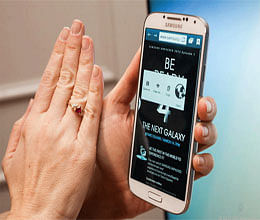
Controlling your smartphone or tablets via gestures can become a reality soon - saying goodbye to touchscreens and sensing technologies that consume a lot of battery power.
Led by an Indian-origin researcher, computer scientists at University of Washington have built a low-cost gesture recognition system that runs without batteries and lets users control their electronic devices hidden from sight with simple hand movements.
The prototype, called 'AllSee', uses existing TV signals as both a power source and the means to detect a user's gesture command.
"This is the first gesture recognition system that can be implemented for less than a dollar and does not require a battery," said Shyam Gollakota, assistant professor of computer science and engineering at University of Washington.
"You can leverage TV signals both as a source of power and as a source of gesture recognition," he explained.
The researchers built a small sensor that can be placed on an electronic device such as a smart phone.
The sensor uses an ultra-low-power receiver to extract and classify gesture information from wireless transmissions around us.
When a person gestures with the hand, it changes the amplitude of the wireless signals in the air.
The 'AllSee' sensors then recognise unique amplitude changes created by specific gestures.
Sensors use three to four times less power than existing gesture recognition systems by harvesting power from wireless transmissions.
This allows for mobile devices to always have the gesture technology on and enabled.
"The user could gesture at the phone in a pocket or handbag to change the volume or mute the phone without having to touch or see the phone," noted Gollakota.
This technology could allow sensors to be attached to household electronics, making it possible to interact with everyday objects using gestures and also connect them to the internet.
The prototype could correctly identify the gestures more than 90% of the time while performed more than two feet away from the device.
"This enables a seamless and interactive experience for the user," said Vamsi Talla, another Indian-origin doctoral student in electrical engineering.
The new technology is set to be showcased at the 'Symposium on Networked Systems Design and Implementation conference' in Seattle April 2-4.
Led by an Indian-origin researcher, computer scientists at University of Washington have built a low-cost gesture recognition system that runs without batteries and lets users control their electronic devices hidden from sight with simple hand movements.
The prototype, called 'AllSee', uses existing TV signals as both a power source and the means to detect a user's gesture command.
"This is the first gesture recognition system that can be implemented for less than a dollar and does not require a battery," said Shyam Gollakota, assistant professor of computer science and engineering at University of Washington.
"You can leverage TV signals both as a source of power and as a source of gesture recognition," he explained.
The researchers built a small sensor that can be placed on an electronic device such as a smart phone.
The sensor uses an ultra-low-power receiver to extract and classify gesture information from wireless transmissions around us.
When a person gestures with the hand, it changes the amplitude of the wireless signals in the air.
The 'AllSee' sensors then recognise unique amplitude changes created by specific gestures.
Sensors use three to four times less power than existing gesture recognition systems by harvesting power from wireless transmissions.
This allows for mobile devices to always have the gesture technology on and enabled.
"The user could gesture at the phone in a pocket or handbag to change the volume or mute the phone without having to touch or see the phone," noted Gollakota.
This technology could allow sensors to be attached to household electronics, making it possible to interact with everyday objects using gestures and also connect them to the internet.
The prototype could correctly identify the gestures more than 90% of the time while performed more than two feet away from the device.
"This enables a seamless and interactive experience for the user," said Vamsi Talla, another Indian-origin doctoral student in electrical engineering.
The new technology is set to be showcased at the 'Symposium on Networked Systems Design and Implementation conference' in Seattle April 2-4.








